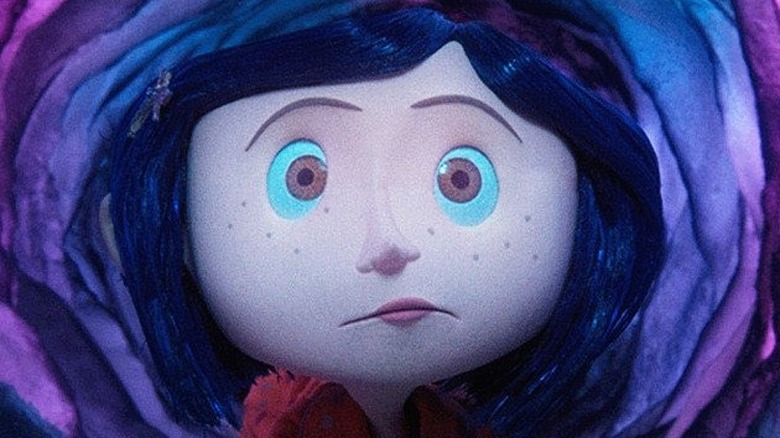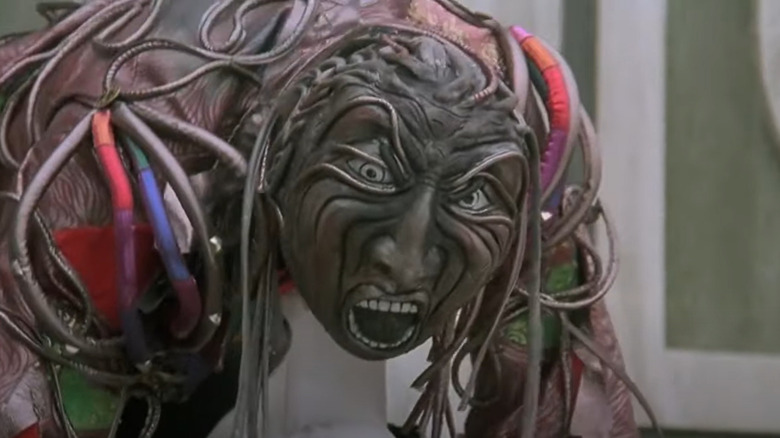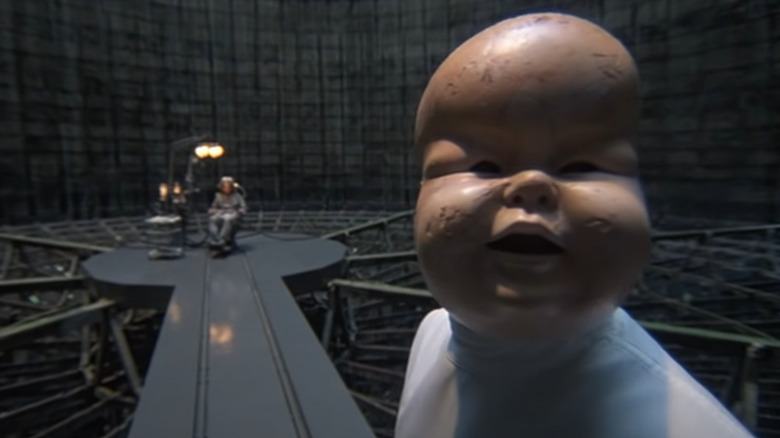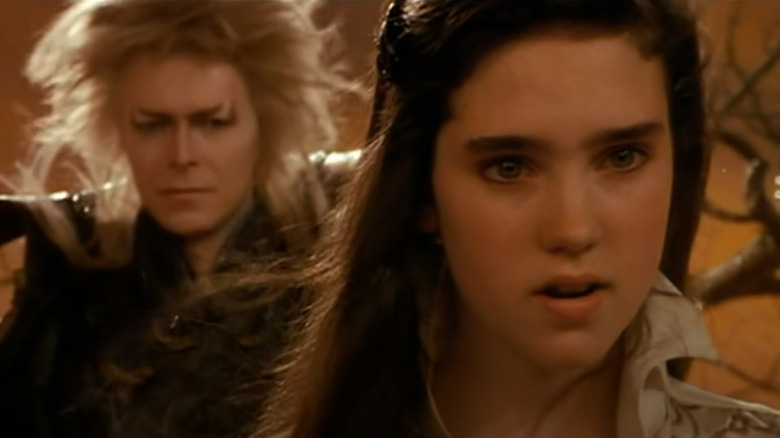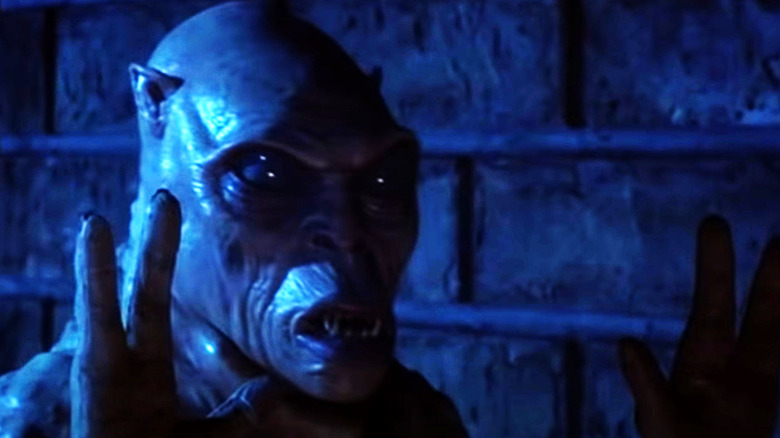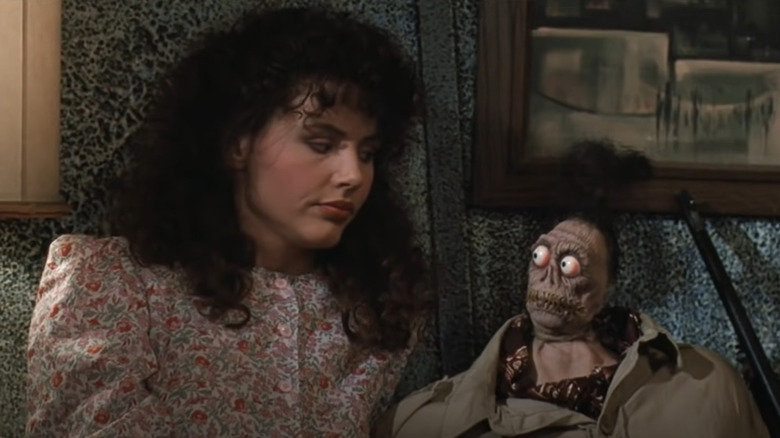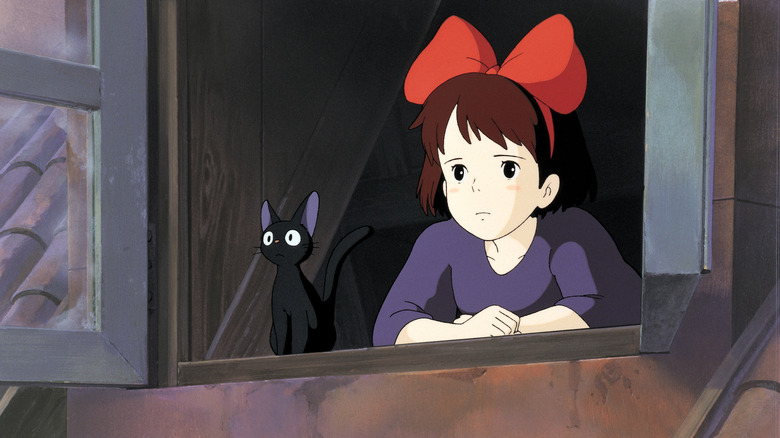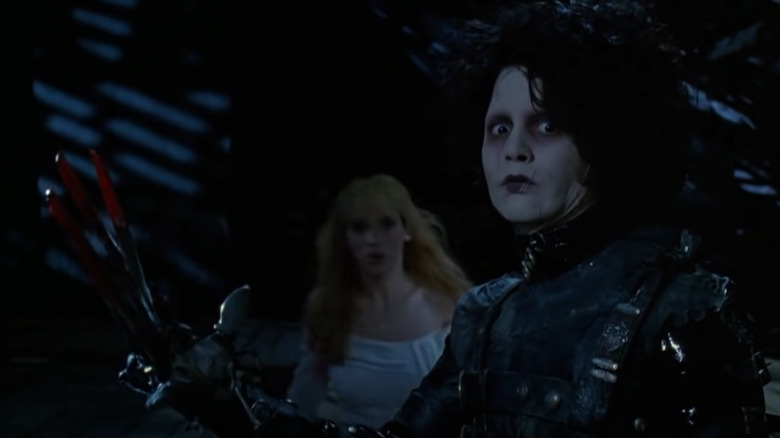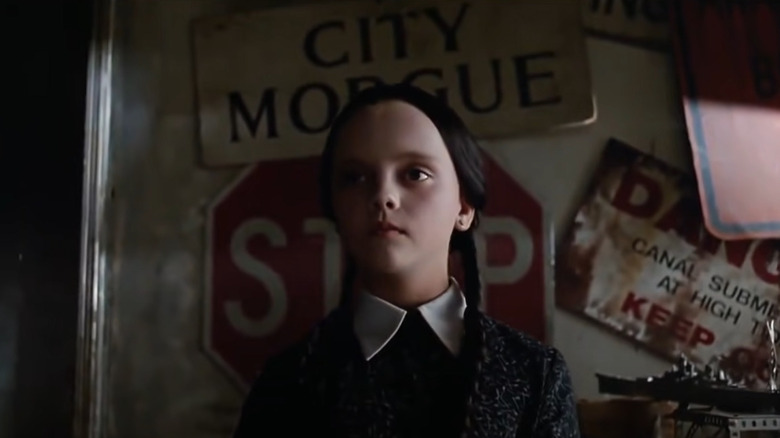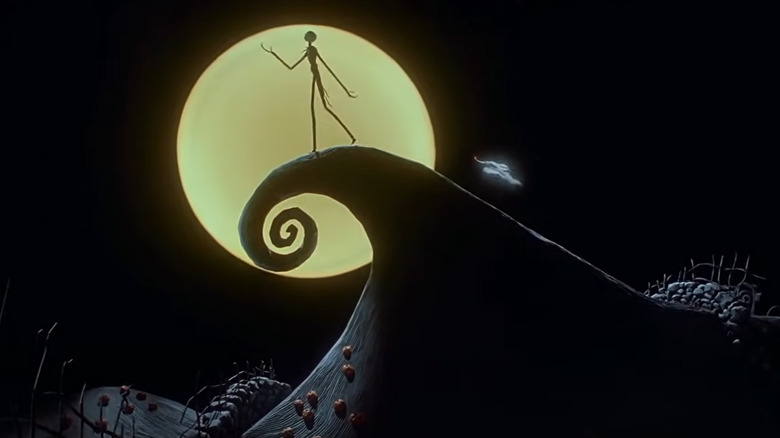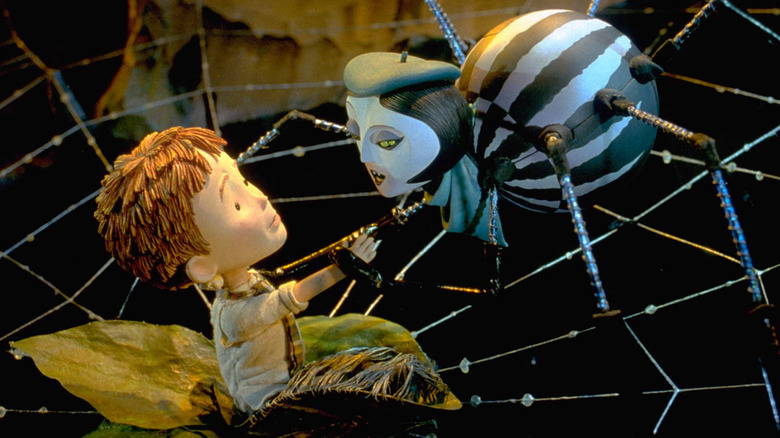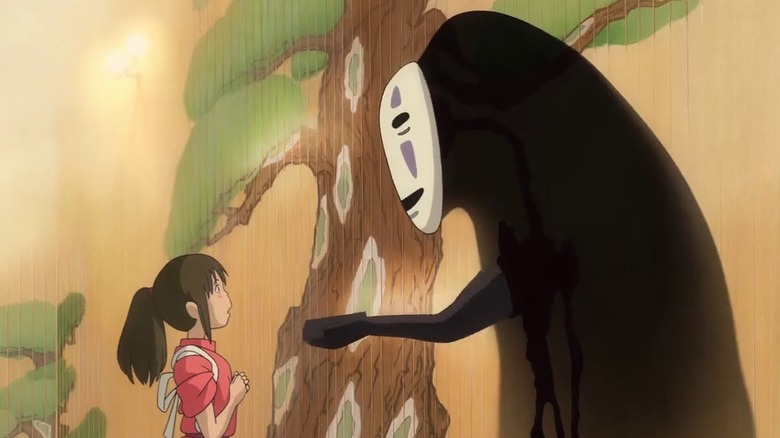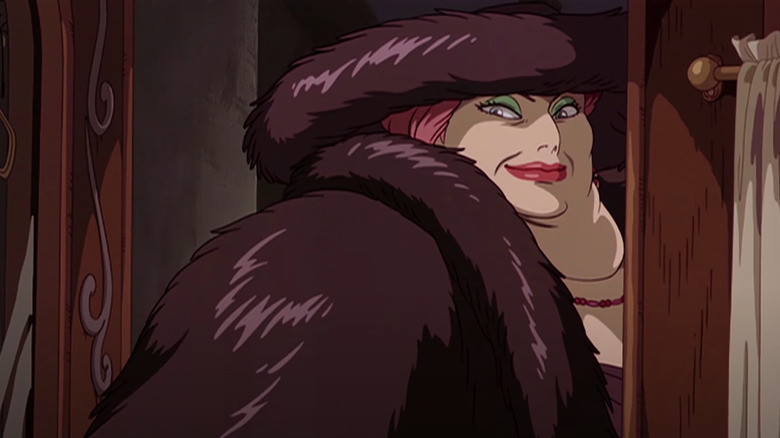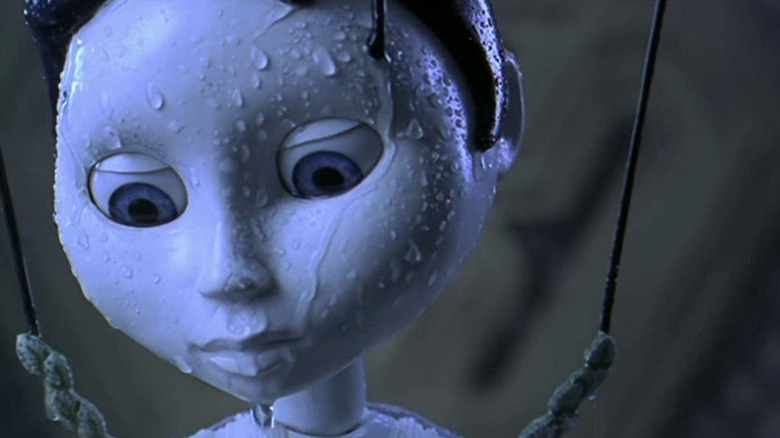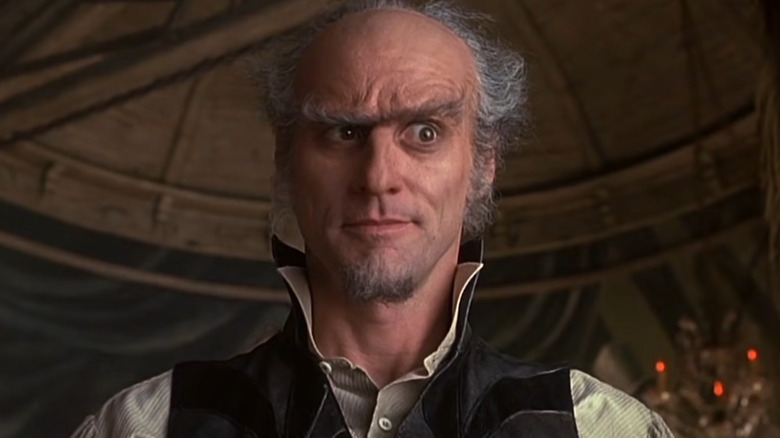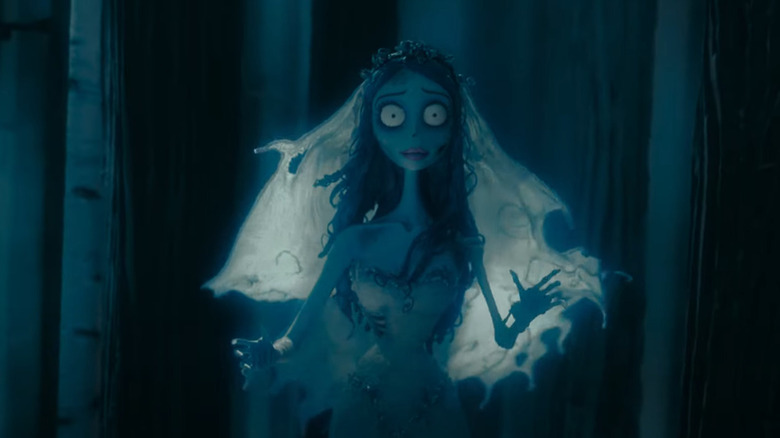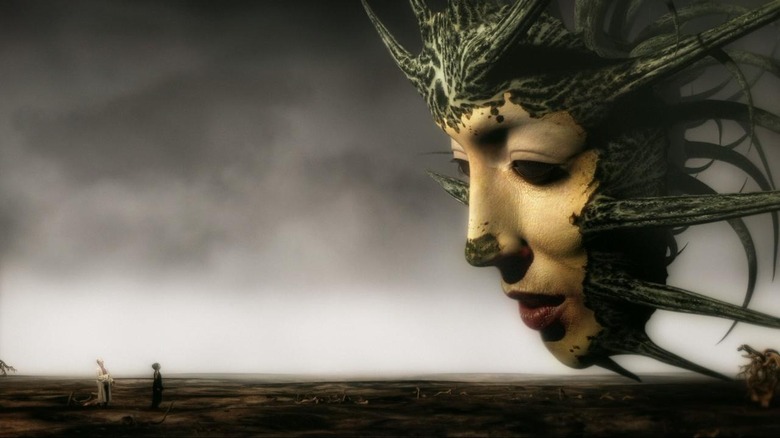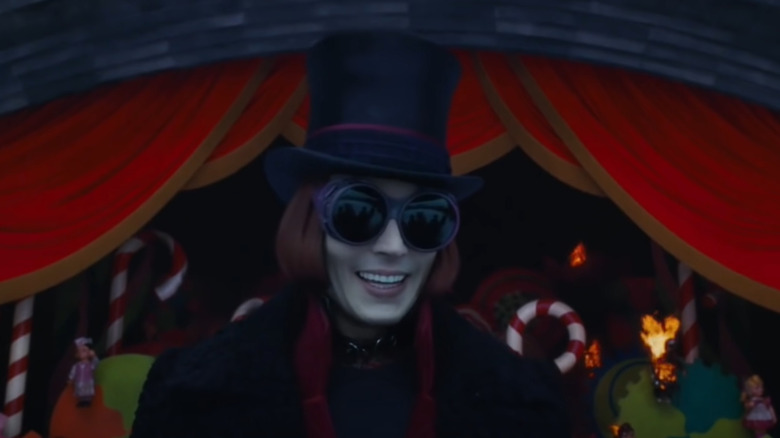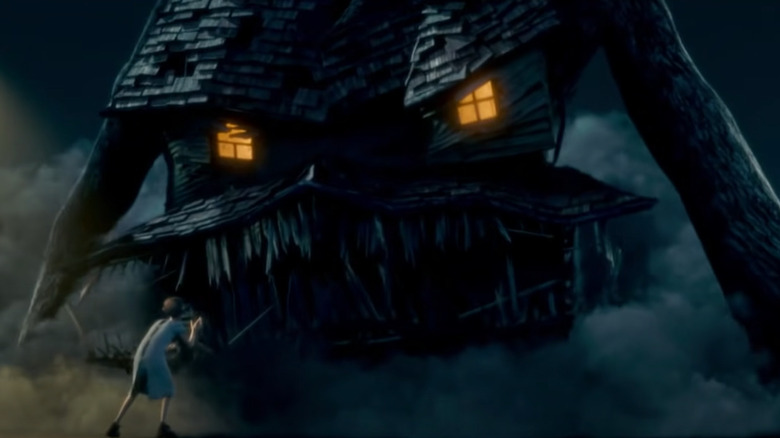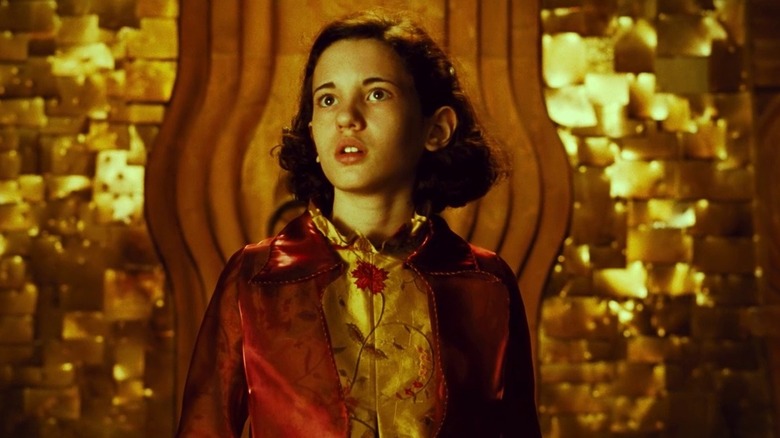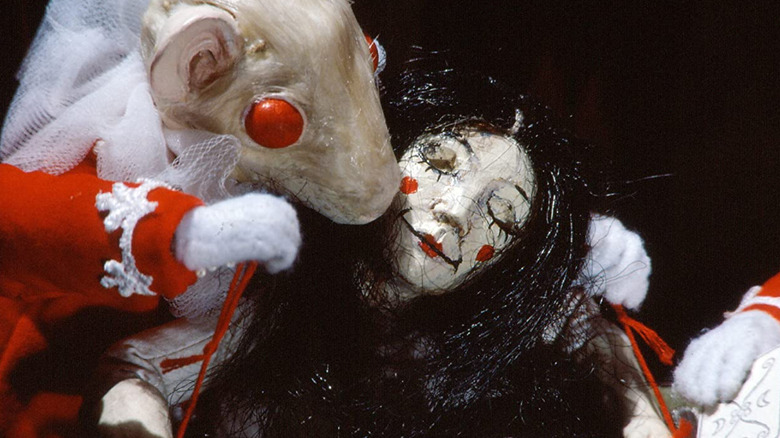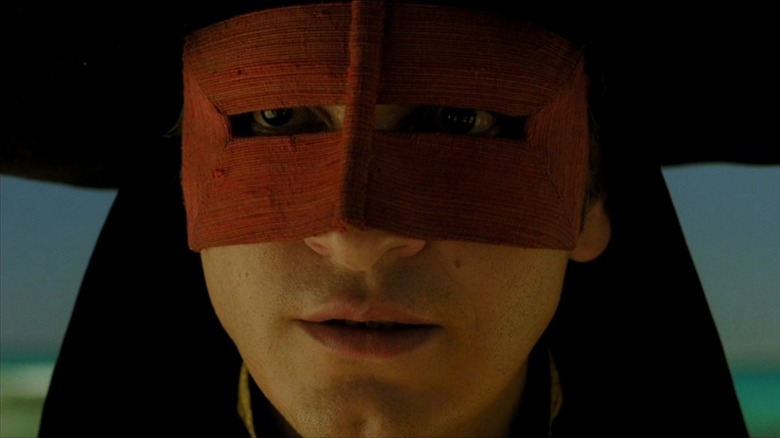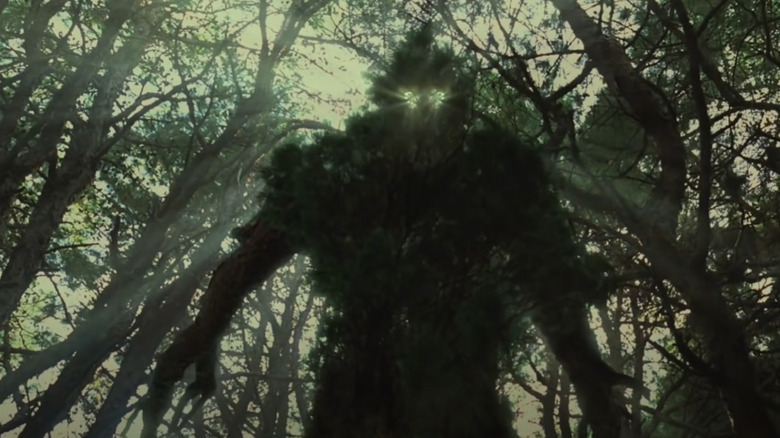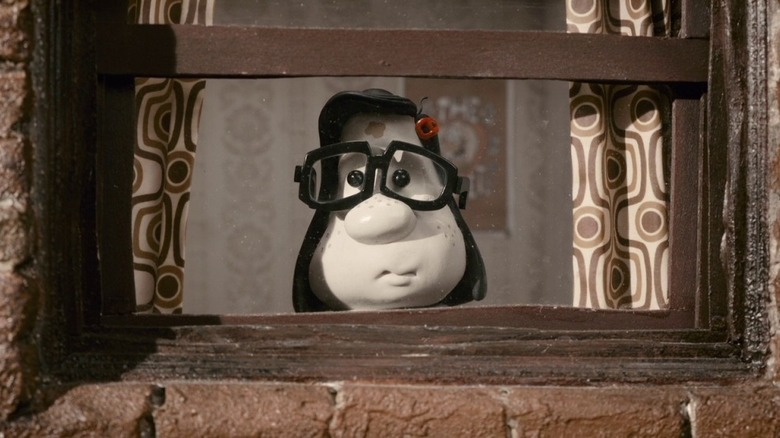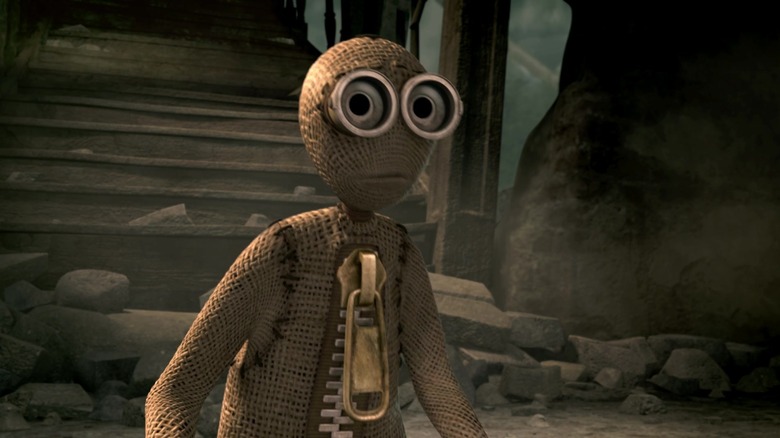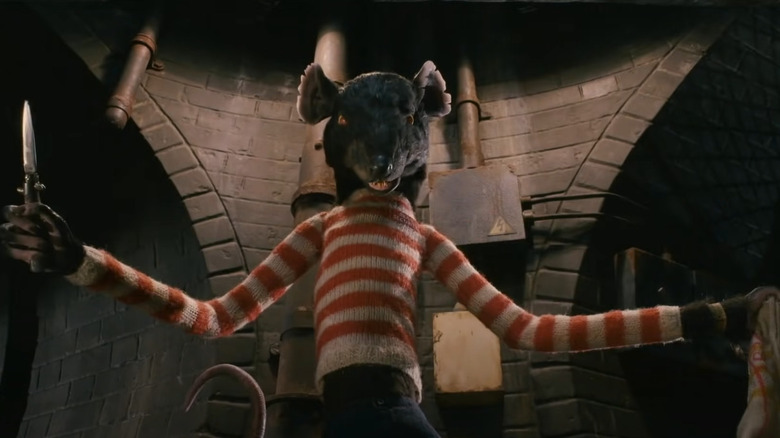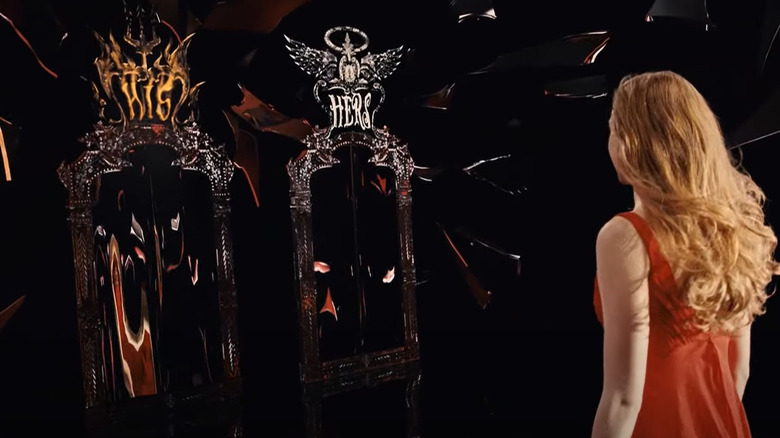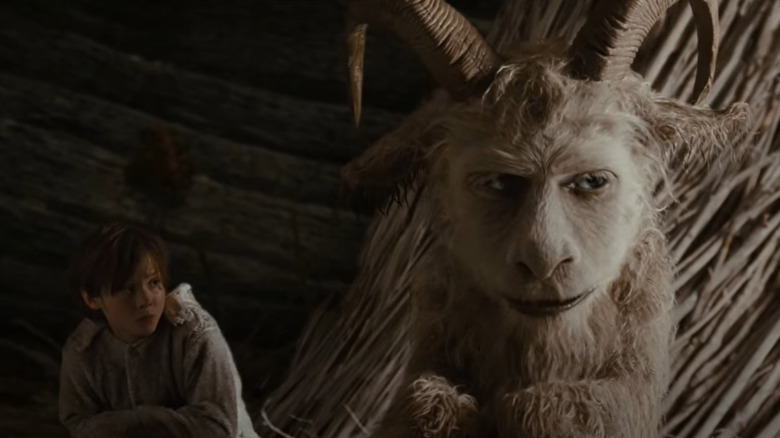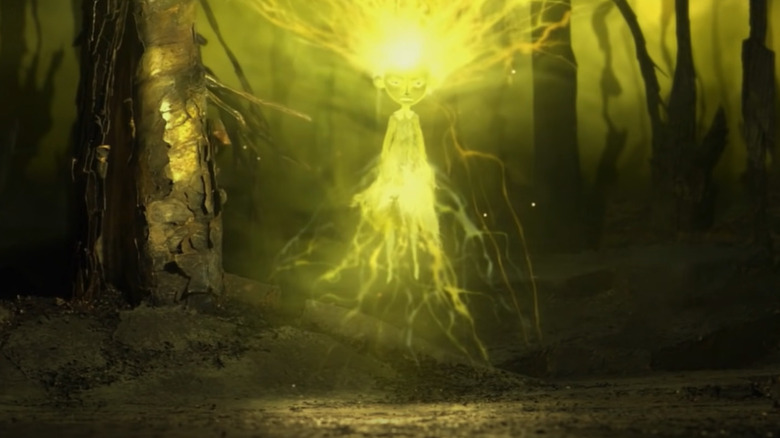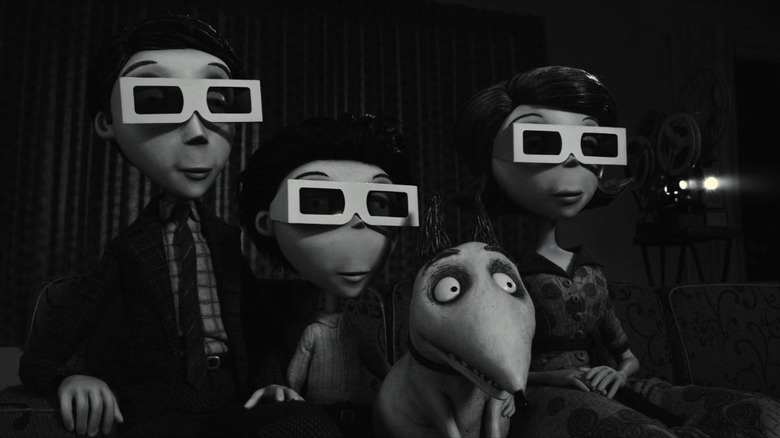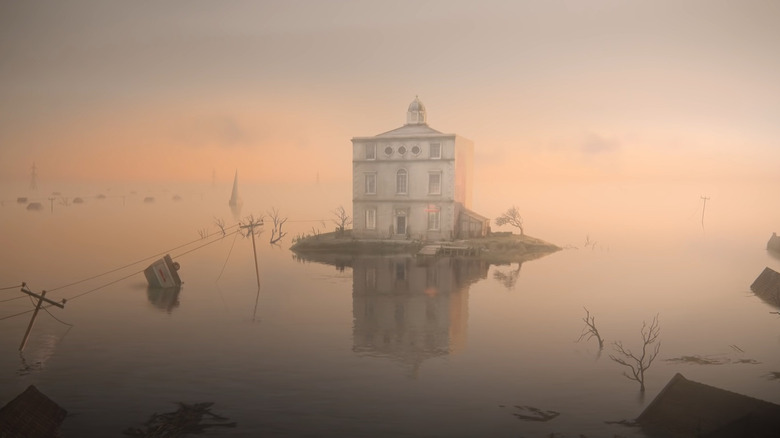30 Creepy Movies Like Coraline You Should Watch Next
At first glance, the 2009 stop motion film "Coraline" looks like a simple, if spooky, children's movie. Under the surface, however, there are more complex themes at play. When combined with the considerably darker-than-average tone looming over the entire film, this makes for an entertaining and memorable experience.
"Coraline" is one of a small collection of films produced by celebrated animation studio Laika. But don't let this modest output make you think there aren't plenty of delightfully frightening films out there for the "Coraline" fan to enjoy. Minds like Wes Anderson, Tim Burton, and Terry Gilliam have all produced work that elicits many of the same moods, aesthetics, and themes that make "Coraline" a popular flick. We're here to take a look at 30 creepy movies every "Coraline" fan should watch next, from dark fantasies to imaginative dystopias.
Return to Oz
"The Wizard of Oz" is one of the most iconic films of all time. Subject to endless parodies and references throughout pop culture since its release over 80 years ago, its cheerful, colorful setting and vibrant characters are among the most memorable in cinema. In contrast, the 1985 film "Return to Oz" captures the original source material's darker tone in a way the classic 1939 film never dreams of.
Dorothy returns to the land of Oz to find it in decay: The Emerald City is in ruins, and threats loom around every corner. To free her imprisoned friends and overthrow the Nome King, she must try to restore Oz to its former splendor. Though the film's theatrical release failed to turn a profit, its additions to the world of Oz are impressive, as well as its considerably more frightening depiction of the mythical land.
Brazil
Terry Gilliam's long and commendable filmography is packed with imaginative — and at times disturbing — stories. One of his earliest works, 1985's "Brazil," is full of both bizarre visuals and a whole host of social commentary.
The dystopian, bureaucratic, and downright insane world that Sam Lowry inhabits is among the bleakest depictions of government surveillance and paranoia science fiction has to offer. Lowry's obsession with finding a woman he repeatedly sees in his dreams leads him down a rabbit hole of government secrecy and trippy visuals no viewer will soon forget. There are enough twists and turns at play here to leave viewers guessing all the way until the final shots of the film. But be warned: This film is rated R, and best watched after the kids are asleep.
Labyrinth
One of the last films directed by the legendary Jim Henson, "Labyrinth" proved to be a box office failure immediately following its 1986 release. Despite this poor reception, it has gone on to become a cult classic among fans of Henson's work and dark fantasy enthusiasts alike. In a fit of rage, Sarah Williams wishes for her baby brother to be taken away by goblins. After this actually happens, she's forced to find her way through the expanse of puzzles, fantastical creatures, and obstacles that is the Labyrinth. Jim Henson's imaginative puppetry, combined with a magnetic performance from David Bowie as Jareth, the main antagonist, solidify "Labyrinth" as a thoroughly enjoyable and unapologetically '80s film.
The Gate
Many of the films on this list explore strange and fantastical worlds that exist in stark contrast to our own mundane lives. The protagonists of these stories often willingly enter these parallel realms to escape their troubles, or to vanquish the foes residing within them. And then you have films like 1987's "The Gate," which focuses on the conflict that arises when beings of the other world try to invade our own.
After a portal is ripped open in 12-year-old Glen's backyard, he inadvertently summons the demons who inhabit the world it connects to. As nightmarish monsters descend upon his home, Glen finds himself locked in a battle from room to room. While the practical effects can be hit or miss, when "The Gate" gets it right, it gets it right. You might even be left questioning how a film like this was ever marketed to kids.
Beetlejuice
Following his feature-length debut, 1985's "Pee-wee's Big Adventure," Tim Burton tackled "Beetlejuice," a film with a distinctively different tone — albeit just as much absurdist comedy. "Beetlejuice" follows a recently deceased couple as they come to terms with death and deal with the titular spirit, who's hellbent on crossing into the mortal world. Although its comical depiction of the afterlife and humorous characters keep it from being a straight-up horror flick, "Beetlejuice" is still full of the macabre visuals and characters that would go on to define Tim Burton's body of work.
Kiki's Delivery Service
"Kiki's Delivery Service" is full of the charm and whimsy director Hayao Miyazaki is famous for. It's definitely a lot less unsettling than most of the films on our list, though it does still incorporate witches' inherent eeriness — just in a decidedly more palatable way. Kiki is a young witch who finds herself in a new city. After her delivery business starts to fail, she loses faith in her own abilities, and, subsequently, starts to lose her powers. Kiki must conquer her own self-doubt to earn her classically beautiful Studio Ghibli ending. If we haven't convinced you to give this one a try yet, know this: Kiki's sidekick is a small, sarcastic cat reminiscent of the one who accompanies Coraline through the Other World.
Edward Scissorhands
Despite Edward's unsettling appearance and the fact that his name sounds like the title of a cheesy slasher flick, "Edward Scissorhands" manages to tell a surprisingly touching and down-to-Earth love story that challenges our preconceptions.
The product of a deceased scientist's wayward experimentation, the nearly mute Edward Scissorhands has lived many years all by his lonesome. But then a local mom and saleswoman stumbles upon him, and promptly brings him home. Despite this early embrace, Edward spends the majority of the film struggling to be accepted by those around him, especially after some are inadvertently injured by his razor-sharp hands. Like many good love stories, this one isn't without tragedy — but it's all worth it in the end.
The Addams Family
Classic '60s sitcom "The Addams Family" became a beloved icon of pop culture during its two-year run. The series' uniquely creepy spin on the squeaky-clean family shows of its era still stands out, decades later. 1991's "The Addams Family" continues this tradition by rebooting the franchise in a decidedly modern way. Ramping up the black comedy and adult jokes while still keeping the core sense of fun, this flick is a solid entry in the "Addams Family" legacy, and its macabre atmosphere is sure to appeal to fans of "Coraline."
The Nightmare Before Christmas
While Tim Burton was involved with the creation of this 1993 flick, it was actually directed by Henry Selick, who would go on to direct "Coraline". While it might be hard to believe, given the film's cultural impact, "The Nightmare Before Christmas" wasn't a smash hit upon release. But eventually, the movie's breathtaking stop-motion animation, combined with Jack Skellington's unique story, propelled "The Nightmare Before Christmas" to success.
Jack Skellington is the Pumpkin King of Halloween Town ... but he's become fascinated by Christmas. This enchanting fusion of holidays is already a fun and unique enough premise unto itself, but when intertwined with a heist plot to kidnap Santa Claus and hijack the yuletide holiday, it becomes something far above your typical Halloween flick. Or is it a Christmas flick? Either way, it's great.
James and the Giant Peach
Tim Burton's name is synonymous with dark fantasy and a whole lot of heart. "James and the Giant Peach," which brings Roald Dahl's classic novel to the big screen, is a sterling example of this blend.
The macabre themes you might expect from Burton and director Henry Selick aren't present in this film — Jack Skellington and his undead friends aren't present. But it does double down on the weird nature of the source material. After James Trotter grows a — you guessed it! — giant peach, he uses it to run away from his abusive aunts and see New York City. He's accompanied by a cast of giant insects who help him on his journey, and ultimately become his new family. Like we said, it's pretty weird — and also totally delightful. Like "Coraline," "James and the Giant Peach" is creepy, but also immensely warm.
Spirited Away
Whether you're an anime fan or not, you'll probably love "Spirited Away," one of the best films in the Studio Ghibli library. After wandering off in an abandoned amusement park,10-year-old Chihiro must go on a journey through the spirit world to save her parents and herself from a cutthroat witch. There's a time limit in play as well: Chihiro loses her name in the spirit world, and will be doomed to reside there permanently if she cannot remember it. This classic film's vibrant portrayal of the spirit realm and its imaginative array of characters will appeal to any fan of "Coraline," and has already landed it in millions of cinephiles' hearts.
Howl's Moving Castle
Another entry from Japanese filmmaker Hayao Miyazaki and Studio Ghibli, "Howl's Moving Castle" follows Sophie, a young woman who is cursed with sudden old age. Soon after embarking on a journey to reverse this hex, she meets a wizard named Howl, who travels the countryside in a massive walking castle. But Howl is being pressured to participate in an ongoing war between two kingdoms, a storyline that serves as commentary on real-world conflict. The imaginative world and beautiful animation of this film make it one of Studio Ghibli's greatest creations — if a slightly more disturbing one.
Strings
One of the most visually unique films on this list, the characters in "Strings" are all real marionette puppets who are more than a little reminiscent of the denizens of the Other World. The film plays with this distinct aesthetic, especially through fleshing out some the unpredictable ways a world inhabited by marionettes would conduct itself. Things kick off with a seemingly standard revenge plot: A ruling king is assassinated, and the heir to the throne seeks justice for his death. What follows is a more complex mystery than you might expect, however, full of deep world-building that incorporates its storytelling medium as an essential plot device.
A Series of Unfortunate Events
When three orphaned children find themselves under the care of their eccentric uncle Olaf, they can scarcely imagine how difficult things are about to get. Olaf wants their family's fortune, and he'll put the Baudelaire siblings through repeated misadventures to steal it. A film adaptation of the first three books of Lemony Snicket's beloved series, 2004's "A Series of Unfortunate Events" is full of absurdist humor. While the topic of death is central to the film's plot and the children's newfound caretaker never seems to have their best interests in mind, the film never finds itself straying too far from its comedic tones. Like Coraline, the Baudelaires are imperiled kids, and they have just as much gumption and nerve.
Corpse Bride
Another gorgeous stop-motion film from Tim Burton, "Corpse Bride" is as spooky as it is heart-warming. After Victor Van Dort botches a wedding ceremony, he retreats into the nearby woods to calm his nerves and practice his vows in solitude. While alone, he inadvertently proposes to a long-dead woman named Emily. What follows is a conflict between his two brides-to-be as he travels through the land of the living and that of the dead, all while trying to get to the bottom of Emily's murder.
MirrorMask
"Coraline" is based on celebrated British author Neil Gaiman's book of the same name. While "MirrorMask" isn't based on one of Gaiman's tomes, he did write it, and his characteristic whimsy and warmth are present in every frame. After fighting with her mother, young Helena is cast into a surreal fantasy realm being overtaken by dark shadows. This odd world is connected to her own, however — especially her relationship with her mother. The film's surreal imagery is as inventive as it is disturbing, with the oddities Helena encounters becoming increasingly bizarre. The heavy use of CGI makes the film an undeniable product of its time, but its sepia-toned world still feels hauntingly dreamlike.
Charlie and the Chocolate Factory
Although Tim Burton's adaptation of Roald Dahl's renowned children's novel might be divisive among fans, it still manages to deliver the eerie style for which he's so well-known. In stark contrast to the 1971 film's bright, cheery, occasionally trippy visuals, Tim Burton's version offers a goth-inflected take on the tale. The gloomy real-world is at odds with the candy-coated glitz and glam of Wonka's factory, providing a feeling of unease throughout the entire film. Johnny Depp's performance as Willy Wonka brings the entire film together, as Charlie, the other children who have won a Golden Ticket, and their family members dive deeper into the bizarre chocolate factory.
Monster House
CGI can be divisive among audiences. Some lament what they feel is filmmakers' overreliance on the tool, while others laud the way it can create outlandish and otherworldly visuals practical effects simply can't. "Monster House" doesn't feature 2D or stop-motion animation like many entries on this list employ, instead making a strong case for CGI through its very creepy scenes and surprisingly grim plot. Three kids set out to destroy the monstrous house that terrorizes their neighborhood — but the truth of its haunted nature is not quite what they expect. The film slowly builds suspense surrounding the mysterious house, especially through the gulf it portrays between the kids' worlds and that of the adults. Like Coraline, the trio is on their own, but that might just be enough.
Pan's Labyrinth
This Oscar-winning 2006 film directed by Guillermo del Toro is about as dark as fairy tales come. Set in Francoist Spain, it follows a young girl named Ofelia, who is led into a fantasy realm that proves to be just as grim as the one she leaves behind. After being told she is the heir to the throne of the underworld, she undergoes three gruesome challenges while intermittently traveling between the real world and the fantastical one. Full of horrific and grotesque monsters as well as brutal scenes of wartime violence, "Pan's Labyrinth" is a bit too much for young viewers who love "Coraline." But its blend of cruelty and splendor has made it a modern classic, especially among fans of dark fantasy.
Blood Tea and Red String
One of the more obscure picks on this list, "Blood Tea and Red String" is just as worthy of your consideration as any blockbuster. Opting to tell its story without any dialogue, this 2006 film relies on its unnerving visuals and haunting stop-motion to deliver a compelling message about class divides. In a strange and isolated fairy tale realm, a community of elite mice rules over a caste of benighted creatures. When those lowly beings are forced to craft a lovely doll resembling a human woman, however, they fall in love with her. After losing their beautiful creation to the mice, the put-upon creatures are spurred onto a journey that will change their world forever. Though this film's frightening themes and visuals are too much for most children, older viewers will surely fall in love with them.
The Fall
The majority of sequences in "The Fall" are lighthearted and winningly theatrical. However, the story underneath these flashy visuals is decidedly somber. After Alexandria, a young girl, and Roy, a severely injured stuntman, find themselves in the same hospital, the two pass the time by crafting an elaborate adventure story. The childlike fairy tale they weave together seems innocent enough, but it is gradually revealed to be anything but. Much like the Other World in "Coraline," the imagined world these protagonists share has real-world stakes — ones that threaten to come to a grievous head.
Bridge to Terabithia
On the surface, "Bridge to Terabithia" appears to be a standard playful adventure film — but beneath its luminous exterior lies tragic reality. Jess and Leslie share the sort of childhood friendship that shapes a person for life. Their fantasy kingdom, Terabithia, is a shared wonder ... but it can't eclipse real-world loss. This 2007 film is an adaptation of the highly controversial 1977 novel of the same name, which was itself inspired by author Katherine Paterson's real-life experiences, as reported by NPR. It's no surprise, then, that this stirring film asks audiences to confront themes of grief and loss. Like "Coraline," "Bridge to Terabithia" digs deeper than most kiddie fare, and delivers an important message that gives viewers of all ages something to reflect on.
Mary and Max
While the majority of the films on this list include fantastical themes and otherworldly settings, this 2009 stop-motion film is firmly grounded in reality, in all its discomfort and intolerance. Beginning in the mid-'70s, "Mary and Max" tells the story of an unlikely pair of pen pals and the respective hardships they face, both within themselves and society at large. Mary is a lonely kid who faces struggles at home and on the playground, while Max is an adult man in a lifelong battle with anxiety. The film tackles heavy themes in a matter-of-fact way, without ever coming across as insensitive. Its creepier aspects don't arrive in strange worlds or dangerous creatures, but the demons that exist within all of us — and that we might conquer, with enough support and love.
9
With such talent as Elijah Wood, Jennifer Connelly, and Martin Landau all pitching in to bring its characters to life, "9" puts a winning sci-fi spin on a classic story of perseverance. The film follows a group of sentient puppets known as "stitchpunks" as they struggle for survival in a dystopian world. Humans have been exterminated by a seemingly endless swarm of bloodthirsty machines, forcing our heroes to solve the mystery of a talisman the titular character carries with him. After more than a few disturbing scenes unfold, viewers will quickly understand the necessity for the film's PG-13 rating. But those who can handle "9" will find much to love in its oddball world.
Fantastic Mr. Fox
One of only two animated films by director Wes Anderson, "Fantastic Mr. Fox" is just as visually beautiful as it is eerie. It also captures the offbeat world of Roald Dahl's classic children's novel while maintaining Anderson's trademark heart and whimsy. After Mr. Fox moves his family into a dangerous area, he and the rest of the nearby animals are forced to defend their land from encroaching farmers. While short on the outright scares "Coraline" brings to the table, "Fantastic Mr. Fox" does present a genuine threat to our main characters in the form of the three farmers, who are shown to be remorseless animal killers. What follows are the sort of over-the-top, convoluted hijinks only Wes Anderson can pull off so smoothly.
The Imaginarium of Doctor Parnassus
A fantasy from the mind of Terry Gilliam, "The Imaginarium of Doctor Parnassus" tells the story of a traveling theater troupe with a magical mirror known as the Imaginarium. The Imaginarium is, in fact, a tool that opens to another realm, allowing all who enter a chance to find self-fulfillment. If they fail, however, their souls become property of Mr. Nick, a personification of the Devil who has followed Dr. Parnassus for years.
This film had its production dramatically impacted by the sudden death of Heath Ledger. Gilliam responded by adding not one, but three other actors: Johnny Depp, Jude Law, and Colin Farrell. Counting Ledger, four actors play the role of Tony Shepard, which ends up being a tremendous service to the film.
Where the Wild Things Are
Released in 2009, "Where the Wild Things Are" faithfully adapts Maurice Sendak's beloved 1963 children's book through the use of CGI, puppetry, and elaborate costumes. When young Max runs away from home to the land of the Wild Things, it seems he's found a place where he belongs. After a while, though, tensions begin to form between him and the creatures of the island. They doubt his credibility as their king, and ultimately expel him from their dreamlike world. Despite its PG rating, this film has dramatic and tense moments and some truly scary creature designs. This gives it an unsettling vibe — one that "Coraline" fans will surely welcome.
ParaNorman
Another film created by Laika, "ParaNorman" offers a foray into the supernatural much like "Coraline," their previous film. Young Norman Babcock can communicate with the dead, to the disbelief of everyone around him. After his powers uncover the town's dark past, Norman is forced to right a centuries-old wrong the town has long since forgotten — one that echoes his own experiences as an outcast. It's hard not to see the relationship between the fictional town of Blithe Hollow, Massachusetts and the real-world town of Salem, home of the infamous Salem witch trials. "ParaNorman" handles this history with compassion and masterful artistry.
Frankenweenie
Tim Burton's many movies almost always feature eerie visuals, somber characters, and a gothic sensibility. While you can't get any darker than its black-and-white color palette, "Frankenweenie" combines this drabness and its grisly subject matter with wonderfully silly and lighthearted moments. A reimagining Burton's 1984 short of the same name, "Frankenweenie" tells the story of a young boy and his recently deceased dog, Sparky, who he reanimates through his technological prowess. Full of callbacks to previous Burton films and plenty of heartwarming scenes, this film is a great entry point into horror for younger viewers, while remaining enjoyable for all ages.
The House
Fans of both horror and stop-motion animation will find much to enjoy in this British anthology film, which slowly develops the story of a house and its residents over the course of several generations. Switching between the past, present, and a dystopian future, the film's cryptic plot leaves many of its details open to interpretation — themes of greed, abandonment, and remorse take precedence. By the end of its relatively short 97 minute runtime, "The House" manages to transform into something entirely different than what viewers may initially expect — but they'll be pleased every step of the way.
